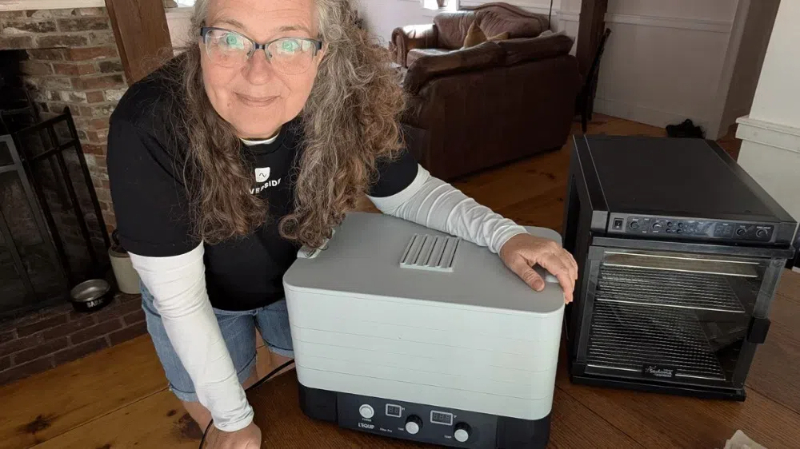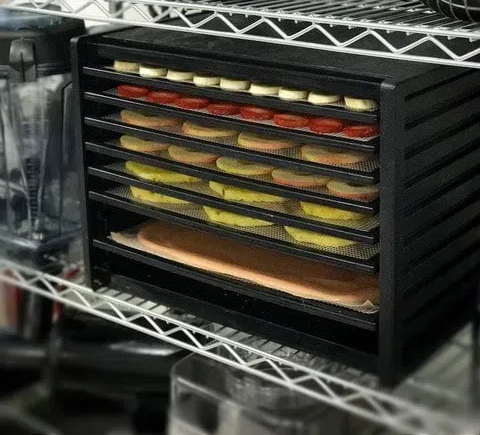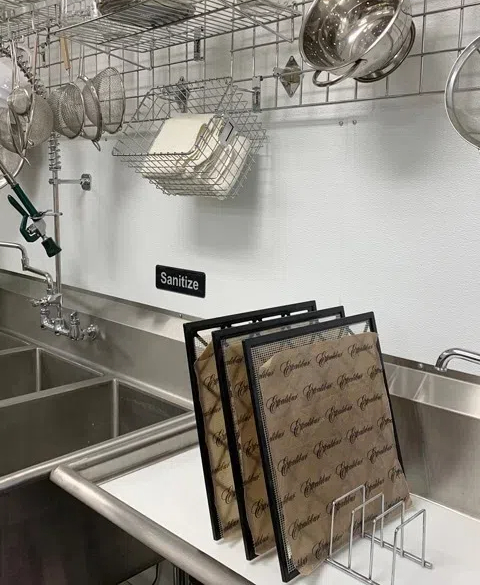
Content Menu
● Why Regular Maintenance Matters
● Key Components of a Cabinet Type Dehydrator
● Step-by-Step Maintenance Guide
>> 1. Cleaning the Trays
>> 2. Cleaning the Cabinet Interior
>> 3. Cleaning the Cabinet Exterior
>> 4. Inspecting the Heating Element
>> 5. Checking the Fan
>> 6. Filter Maintenance
>> 7. Checking Electrical Connections
>> 8. Proper Storage
>> 9. Addressing Common Issues
>> 10. Calibrating the Thermostat
● Additional Tips for Optimal Maintenance
● Conclusion
● FAQ
>> 1. How often should I clean my dehydrator?
>> 2. Can I use dish soap to clean the dehydrator trays?
>> 3. What should I do if the heating element is damaged?
>> 4. How can I prevent food from sticking to the trays?
>> 5. Where should I store my dehydrator when it's not in use?
● Citations:
As a Chinese food dehydrator manufacturing factory providing OEM services, it's crucial to equip your partners—brands, wholesalers, and manufacturers—with comprehensive maintenance knowledge. This ensures the longevity, efficiency, and hygiene of cabinet type dehydrators. This guide provides essential maintenance tips, incorporating images, videos, FAQs, and relevant keywords to optimize its utility.

Why Regular Maintenance Matters
Regular maintenance is paramount for several reasons:
-Extending Lifespan: Consistent care prevents wear and tear, significantly prolonging the dehydrator's operational life. Neglecting maintenance can lead to premature failure of critical components, resulting in costly replacements.
-Maintaining Performance: Cleanliness and proper upkeep ensure optimal drying performance, preventing uneven dehydration and potential flavor contamination. A build-up of residue can impede airflow, reducing efficiency.
-Ensuring Food Safety: Regular cleaning eliminates bacteria and mold growth, ensuring the safety of dehydrated products. This is especially critical when dehydrating meats or fruits with high sugar content, which can be breeding grounds for microorganisms if not properly cleaned.
-Reducing Downtime: Proactive maintenance minimizes unexpected breakdowns and costly repairs. Regularly checking and maintaining the dehydrator allows you to identify and address potential issues before they escalate into major problems.
-Enhancing Energy Efficiency: A well-maintained dehydrator operates more efficiently, reducing energy consumption and operational costs. A dirty or malfunctioning dehydrator will require more energy to achieve the same level of drying, increasing operating costs.
Key Components of a Cabinet Type Dehydrator
Understanding the key components helps in targeted maintenance:
-Heating Element: Provides the heat necessary for drying. The heating element must be free from dust and obstructions to function efficiently.
-Fan: Circulates hot air evenly throughout the cabinet. The fan is responsible for ensuring consistent drying throughout the dehydrator.
-Trays: Hold the food items during dehydration. Trays must be cleaned and well-maintained to prevent food from sticking and to ensure proper airflow.
-Control Panel: Manages temperature, timer, and other settings. The control panel is the brain of the dehydrator and must be kept clean and functional.
-Cabinet: Encloses and insulates the dehydrator. The cabinet provides insulation and ensures that heat is retained within the unit.
Step-by-Step Maintenance Guide
1. Cleaning the Trays
Frequency: After each use.
Process:
1. Remove the trays from the cabinet.
2. Wash with warm, soapy water using a soft sponge.
3. Rinse thoroughly with clear water to remove soap residue.
4. Dry immediately with a clean cloth.
Tips:
-Avoid harsh chemicals or abrasive scrubbers to prevent damage. These can scratch or damage the trays, leading to further issues.
-For stubborn residue, soak trays in warm, soapy water before washing. Adding a bit of baking soda to the soaking water can help loosen tough stains.
-Consider using a dishwasher-safe tray liner for easy cleaning.

2. Cleaning the Cabinet Interior
Frequency: After each use.
Process:
1. Ensure the dehydrator is turned off and unplugged.
2. Allow the unit to cool completely.
3. Wipe the interior with a damp cloth or sponge.
4. Pay special attention to areas with food spills or residue.
Cautions:
-Do not splash water onto the heating element.
-Never immerse the dehydrator in water. This can cause electrical damage and pose a safety hazard.
-For stubborn stains, use a mixture of water and vinegar.
-Ensure the interior is completely dry before the next use to prevent mold growth.
3. Cleaning the Cabinet Exterior
Frequency: Regularly, as needed.
Process:
1. Wipe the exterior with a damp cloth.
2. Use a mild detergent for stubborn stains.
3. Dry with a clean cloth.
Additional Tips:
-Avoid using abrasive cleaners that can scratch the surface.
-Clean the control panel with a soft, dry cloth.
-Regular cleaning prevents the build-up of grime and keeps the dehydrator looking its best.
4. Inspecting the Heating Element
Frequency: Every 3-6 months.
Process:
1. Ensure the dehydrator is unplugged.
2. Visually inspect the heating element for damage or corrosion.
3. If necessary, use a soft brush to remove dust.
Note:
-If the heating element is damaged, consult a professional for repair. Do not attempt to repair it yourself unless you are a qualified technician.
-Look for signs of overheating, such as discoloration or burnt areas.
-Regular inspections can help identify potential problems before they lead to failure.
5. Checking the Fan
Frequency: Every 3-6 months.
Process:
1. Ensure the dehydrator is unplugged.
2. Check the fan for any obstructions or damage.
3. Clean the fan blades with a soft brush.
Note:
-A malfunctioning fan can lead to uneven drying; repair or replace as needed. Uneven drying can result in some food being over-dried while other parts remain moist.
-Listen for unusual noises, such as squealing or grinding, which can indicate a problem with the fan motor.
-Ensure the fan blades are securely attached to the motor.
6. Filter Maintenance
Frequency: As needed, depending on usage.
Process:
1. Locate the filter (if applicable).
2. Remove the filter and clean it with a brush or vacuum.
3. Replace the filter if it is damaged or excessively dirty.
Additional Notes:
-Some dehydrators may not have filters.
-Filters help to keep dust and debris out of the dehydrator, ensuring cleaner and safer drying.
-A clogged filter can reduce airflow and decrease efficiency.
7. Checking Electrical Connections
Frequency: Every 6-12 months.
Process:
1. Ensure the dehydrator is unplugged.
2. Inspect the power cord for fraying or damage.
3. Check the electrical connections for looseness or corrosion.
Warning:
-Do not use the dehydrator if the power cord is damaged. Replace the power cord immediately to prevent electrical shock.
-Consult a qualified electrician for any electrical repairs.
-Loose connections can cause overheating and pose a fire hazard.
8. Proper Storage
When: When not in use.
How:
1. Clean the dehydrator thoroughly.
2. Store in a cool, dry place away from direct sunlight.
3. Cover the dehydrator to protect it from dust.
Tips:
-Avoid storing the dehydrator in damp or humid environments, as this can lead to corrosion.
-Cover the dehydrator with a cloth or plastic cover to protect it from dust and debris.
-Store the dehydrator in a location where it will not be exposed to extreme temperatures.
9. Addressing Common Issues
-Uneven Drying: This can be caused by overcrowding the trays, an uneven temperature distribution, or a malfunctioning fan. Ensure proper spacing between food items and check the fan for proper operation.
-Food Sticking to Trays: Use parchment paper or non-stick dehydrator sheets. Ensure the trays are properly cleaned before each use.
-Unpleasant Odors: Clean the dehydrator thoroughly and ensure there is no food residue trapped inside. Use a mixture of water and vinegar to eliminate odors.
-Slow Drying Times: This can be caused by a clogged filter, a malfunctioning heating element, or a low temperature setting. Check the filter, inspect the heating element, and ensure the temperature is set correctly.
10. Calibrating the Thermostat
-Frequency: Annually, or if you suspect temperature inaccuracies.
-Process: Use an oven thermometer placed inside the dehydrator to verify the accuracy of the thermostat. Adjust the thermostat according to the manufacturer's instructions if necessary. Inaccurate temperature readings can lead to under- or over-dried food.
Additional Tips for Optimal Maintenance
-Refer to the Manual: Always consult the manufacturer's manual for specific maintenance instructions. Each dehydrator model may have unique requirements.
-Monitor Performance: Pay attention to any unusual noises, smells, or changes in drying performance. Early detection of issues can prevent major problems.
-Professional Servicing: Schedule regular servicing with a qualified technician, especially for commercial units. Professional servicing can identify and address issues that may not be apparent during routine maintenance.
-Record Maintenance: Keep a log of all maintenance activities to track performance and identify potential issues. This log can also be helpful for warranty claims or troubleshooting.
Conclusion
Maintaining your cabinet type dehydrator is essential for ensuring its longevity, efficiency, and the safety of your dehydrated products. By following these step-by-step maintenance tips, you can keep your dehydrator in top condition, reduce downtime, and produce high-quality results consistently. Regular cleaning, inspection, and proper storage are key to a reliable and efficient dehydration process.

FAQ
1. How often should I clean my dehydrator?
It is recommended to clean your dehydrator after each use. This prevents the build-up of food particles and ensures your machine is always ready for the next batch.
2. Can I use dish soap to clean the dehydrator trays?
Yes, you can use mild dish soap to clean the dehydrator trays. Make sure to rinse them thoroughly with water after cleaning to remove any soap residue.
3. What should I do if the heating element is damaged?
If the heating element is damaged, consult a professional for repair. Do not attempt to repair it yourself, as this could be dangerous.
4. How can I prevent food from sticking to the trays?
To prevent food from sticking to the trays, you can use parchment paper or non-stick dehydrator sheets. These provide a barrier between the food and the tray, making it easier to remove the dehydrated items.
5. Where should I store my dehydrator when it's not in use?
When you're not using your dehydrator, make sure to store it in a cool, dry place away from direct sunlight. This will help prevent any damage to the machine and keep it in good working condition for years to come.
Citations:
[1] https://www.pressurecooker-outlet.com/Manuals/Weston-Steel-Dehydrator.pdf
[2] https://www.electrolux-ui.com/DocumentDownLoad.aspx?DocURL=2011%5C136%5C918250umEN.pdf
[3] https://www.dryeratech.com/how-to-properly-maintain-your-dehydrator-machine.html
[4] https://shop.howlifeusa.com/zh/washing-machine/
[5] https://images.thdstatic.com/catalog/pdfImages/1e/1e6fc46e-78ce-434a-b5be-4990ea1746f7.pdf
[6] https://patents.google.com/patent/CN1110593C/zh
[7] https://septree.com/blogs/news/do-food-dehydrators-home-commercial-need-regular-maintenance
[8] http://download.beko.com/Download.UsageManualsBeko/CN/25219_1_2960310325_KM.pdf
[9] https://cuisinart.com.au/sites/cuisinart/media/information-booklets/dhr-20a-ib-16_139.pdf











